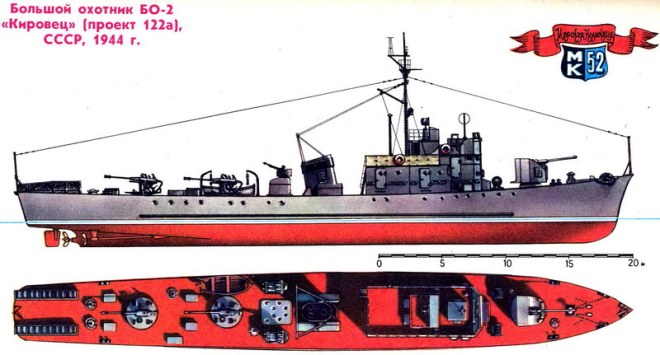
Baltic greyhounds, i.e. project 122bis hunters
ORP Niebany, 1968 photo. collection of the MV Museum
For 15 years, the big Project 122bis submarine hunters formed the backbone of the Polish PDO forces. Attackers may add that these were the first and last real hunters in the Polish fleet, and, unfortunately, they will be right. This is the story of eight ships of this project under the white and red flag.
Little is known about the service of the Polish "deys" under the Soviet flag. After the construction, four (the future Zorn, Maneuverable, Artful and Terrible) were included in the commands of the 4th Baltic Fleet of the USSR (or the Southern Baltic Fleet), and four more - of the 8th Baltic Fleet of the USSR ( Northern Baltic Fleet). On December 24, 1955, both of them were merged into one Baltic Fleet (hereinafter referred to as the Baltic Fleet), but only four of them survived. The ships captured by Poland in 1955 were officially listed as part of the Soviet fleet on June 25, 1955, and the remaining four on February 5, 1958. It is known that all of them were partially modernized in 1954-1955, like most of the ships of this type. Radar "Neptune" was replaced by "Lin", a second warning device KLA and devices "Krymny-2" of the "dom-dom" system were added. The newer model was also replaced by sonar (from Tamir-10 to Tamir-11). In addition, on four ships built in 1950-1951, the radars were changed twice, since first in 1952, instead of Guis-1M, Nieptune was installed, and later removed.
Service of "deevs" in the Polish Navy (first 10 years)
The first four Project 122bis speeders entered our fleet on May 27, 1955, as part of the Supervisory and Large Racing Squadron created on the same day. They were leased for a period of 7 years on the basis of an agreement concluded in September last year. After the white and red flags were hoisted on them, a group of Soviet specialists remained on each of them for three months, transferring their knowledge to the Polish crews.
The annual cost of renting each rider was estimated at PLN 375. rubles. Since this was the first (not counting the transfer of 23 units in April 1946) such a deal with the Soviet Union, due to inexperience, the capture of ships was carried out very quickly, without proper verification of many important issues. The transfer documents were very short, only two pages per ship. Two-hour outings at sea could not reveal all the shortcomings, which began to appear only after several weeks of getting used to the crews to new duty stations. It quickly became clear that many ship mechanisms operate outside the established norms for overhaul. Shortcomings in the technical documentation did not allow for an adequate supply of spare parts. Artillery systems in general were in a deplorable state. All these comments were recorded during the work of a special commission established in November 1955. For hunters, deplorable grades meant the interruption of crew training and an urgent transition to the Navy.
in Gdynia (SMZ) for current repairs. They were manufactured on all four ships during 1956.
